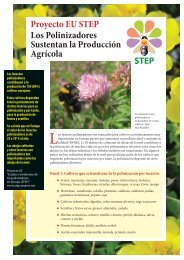Global Honey Bee Colony Disorder and Other Threats to Insect
Global Honey Bee Colony Disorder and Other Threats to Insect
Global Honey Bee Colony Disorder and Other Threats to Insect
You also want an ePaper? Increase the reach of your titles
YUMPU automatically turns print PDFs into web optimized ePapers that Google loves.
1. Pollination <strong>and</strong> pollina<strong>to</strong>rsPollination is the transfer of pollen from a flower’s male organs <strong>to</strong> a flower’s femaleorgans. This process is critical <strong>to</strong> fruit <strong>and</strong> seed production <strong>and</strong> is usually providedby insects <strong>and</strong> other animals searching for nectar, pollen or other floral benefits.Pollination is vital <strong>to</strong> our ecosystems <strong>and</strong> <strong>to</strong> human societies. The health <strong>and</strong> wellbeingof pollinating insects are crucial <strong>to</strong> life, be it in sustaining natural habitats orcontributing <strong>to</strong> local <strong>and</strong> global economies (Figure1).Figure 1: Economic impact of insect pollination on agricultural production useddirectly for human food worldwideAverage valueCrop category of a production unitEconomic value (10 9 €)(€ per metric <strong>to</strong>nne)50 100 150 200 250 300 350 400 450Vegetables468Cereals139Sugar crops177Edible oil crops385Fruits452Roots <strong>and</strong> tubers137Pulse515Stimulant crops1 225<strong>Insect</strong> pollination economic valueNuts1 269Total economic valueSpices1 0031 618All categories pooled <strong>to</strong>getherThe contribution of pollina<strong>to</strong>rs <strong>to</strong> the production of crops used directly for human food has been estimated at€153 billion globally, which is about 9.5% of the <strong>to</strong>tal value of human food production worldwide 6 .Animal-mediated pollination boosts the reproduction of wild plants on which otherservices or service-providing organisms depend. Some commercial plants, suchas almonds or blueberries, do not produce any fruit without pollina<strong>to</strong>rs. For many,a well-pollinated flower will contain more seeds, with an enhanced capacity <strong>to</strong>germinate, leading <strong>to</strong> bigger <strong>and</strong> better-shaped fruit. Improved pollination can alsoreduce the time between flowering <strong>and</strong> fruit set, reducing the risk of exposing fruit <strong>to</strong>pests, disease, bad weather, agro-chemicals <strong>and</strong> saving on water.attract reproductive assistants in exchange for food rewards. These co-adaptationscan be so specialized that the loss of one species threatens the existence of another.This raises troubling questions about the potential consequences of decliningdiversity in pollination networks 7 − an ecosystem service that is often cited asendangered in scientific literature.2. Variation in managed pollina<strong>to</strong>r populationsAmong the 20 000 known bee species worldwide, the most common domesticatedbees are honey bees, Apis mellifera. Native <strong>to</strong> Europe, Asia <strong>and</strong> Africa, theirvalue ranges from honey production, wax, propolis <strong>and</strong> royal jelly, <strong>to</strong> the efficientpollination of crops. <strong>Honey</strong> bees remain the most economically valuable pollina<strong>to</strong>rsfor crop monocultures worldwide. Yields of certain fruit, seed <strong>and</strong> nut crops decreaseby more than 90% without these highly efficient pollina<strong>to</strong>rs 8 .It is problematic <strong>to</strong> estimate the global economic value of the pollination servicesprovided by managed species, as it is difficult <strong>to</strong> know if crops have been pollinatedby managed or wild individuals. Nevertheless, recent estimates range between€22.8 <strong>to</strong> 57 billion 9 , including apiculture markets <strong>and</strong> particularly all cash-cropyields.Figure 2: Mean theoretical honey bee population per hive <strong>and</strong> by season intemperate regionsNumber of bees in the colony70 00060 00050 00040 00030 00020 000wintering phase10 000development phaseswarming phasebeekeeping seasonwinteringpreparation phasewintering phase2Mutually beneficial relationships have developed over time between pollina<strong>to</strong>rana<strong>to</strong>my <strong>and</strong> plant flower structures – as well as mechanisms that plants use <strong>to</strong>__________________________________Jan Feb Mar Apr May Jun Jul Aug Sep Oct Nov DecData source: French Agency for Environmental <strong>and</strong> Occupational Health Safety (AFSSET), “Weakening,collapse <strong>and</strong> mortality of bee colonies”, November 2008 – Updated April 2009.7Fontaine C. et al. 2006. “Functional diversity of plant-pollina<strong>to</strong>r interaction webs enhances the persistence of plant communities”. PLoS Biol 4(1): e1 <strong>and</strong> “Diverse Pollination Networks Key <strong>to</strong> Ecosystem Sustainability”.PLoS Biol 4(1): e128Klein A.M., Vaissière B. et al. 2007. “Importance of pollina<strong>to</strong>rs in changing l<strong>and</strong>scapes for world crops”. Proceedings of the Royal Society B: 274, 303–313.9Simon Potts, Centre for Agri-Environment Research, University of Reading in “<strong>Bee</strong>s <strong>and</strong> flowers decline in step”, by Richard Black, Environment correspondent, 20 July 2006, BBC News website. See http://news.bbc.co.uk/2/hi/science/nature/5201218.stmG L O B A L B E E C O L O N Y D I S O R D E R S A N D O T H E R T H R E A T S T O I N S E C T P O L L I N A T O R S




